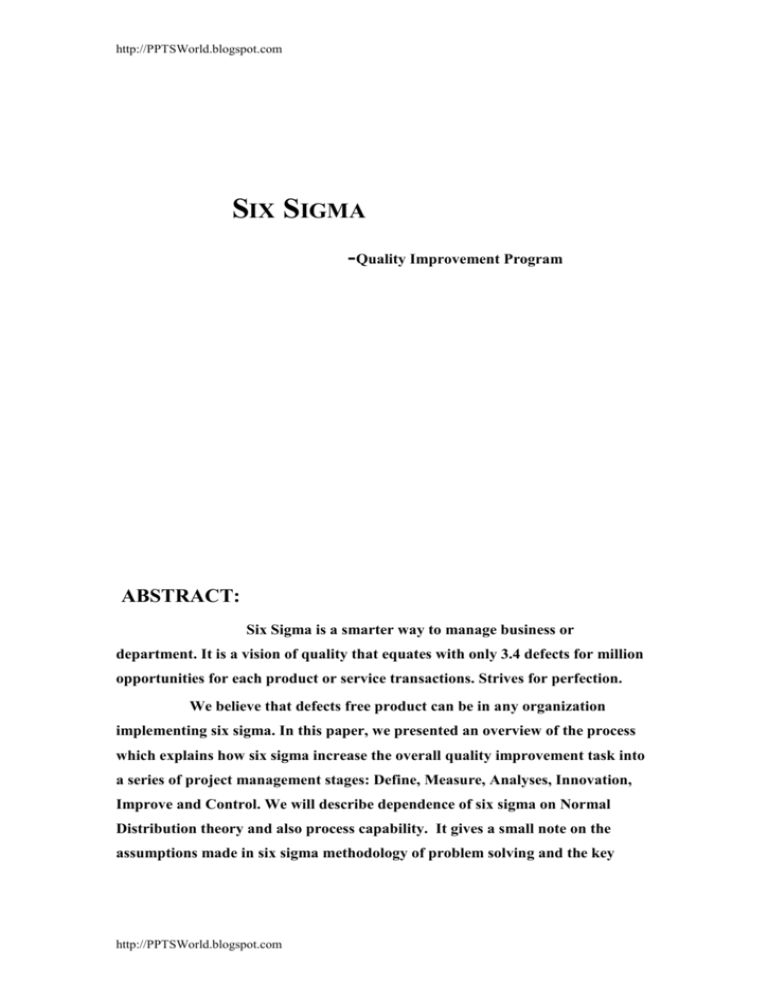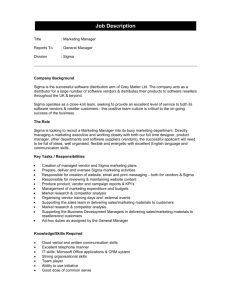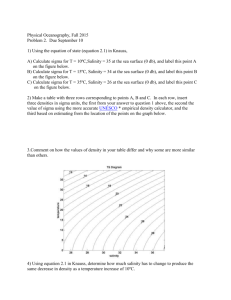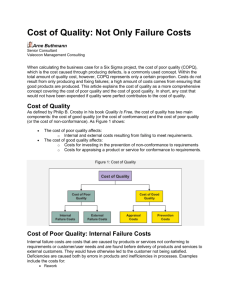6 SIGMA= 3.4 defects per million
advertisement

http://PPTSWorld.blogspot.com SIX SIGMA -Quality Improvement Program ABSTRACT: Six Sigma is a smarter way to manage business or department. It is a vision of quality that equates with only 3.4 defects for million opportunities for each product or service transactions. Strives for perfection. We believe that defects free product can be in any organization implementing six sigma. In this paper, we presented an overview of the process which explains how six sigma increase the overall quality improvement task into a series of project management stages: Define, Measure, Analyses, Innovation, Improve and Control. We will describe dependence of six sigma on Normal Distribution theory and also process capability. It gives a small note on the assumptions made in six sigma methodology of problem solving and the key http://PPTSWorld.blogspot.com http://PPTSWorld.blogspot.com elements involved .A brief view on Defects Per Million Opportunities (DPMO) Analysis is given. Ultimate objectives of the methodology to solve problems, improve the quality, profitability and customers satisfaction. INTRODUCTION: The main objective of any business is to make profit. For increasing the profit, the selling price should increase and/or the manufacturing cost should come down. Since the price is decided by the competition in the market, hence the only the way to increase the profit is to cut down the manufacturing cost which can be achieved only through continuous improvement in the company’s operation. Six sigma quality programs provide an overall framework for continuous improvement in the process of an organization. Six sigma uses facts, data and root cause to solve problems. EVOLUTION OF SIXSIGMA: Six sigma background stretches back eighty plus years, from management science concepts developed in the United States to Japanese management breakthroughs to “TOTAL QUALITY “ efforts in 1970s and 1980s. But the real impacts can be seen in the waves of change and positive results sweeping such companies as GE, MOTOROLA, JOHNSON &JOHNSON and AMERICAN EXPRESS. CONCEPTS: Six sigma is defined a customer oriented, structured, systematic, proactive and quantitative company wide approach for continuous improvement of manufacturing, services, engineering, suppliers and other business process. It is a statistical measure of the performance of a process or a product. It measures the degree to which the process deviates from the goals and then takes efforts to improve the process to achieve total customer satisfaction. Six sigma efforts target three main areas: Improving customer satisfaction. http://PPTSWorld.blogspot.com http://PPTSWorld.blogspot.com Reducing cycle time. Reducing defects. Three key characteristics separates six sigma from quality programs of the past: 1. Six Sigma is a customer focused. 2. Six sigma projects produce major returns on investments. 3. Six sigma changes how management operates. 6 SIGMA= 3.4 defects per million Six Sigma equates 3.4 defects for every million parts made or process transactions carried out. This quality equates to 99.99966% defect free products or transactions. High quality standards do make sense but the cost required to pursue such high standards have to be balanced with benefits gained. The six sigma processes exposes the root causes and then focuses on the improvements to achieve the highest level of quality at acceptable cost. This is essential to achieve and maintain a competitive advantage and high levels of customer satisfaction and loyalty. When we say that a process is at six sigma level, such a process is normally yield two instances of non-conformances out of every million opportunities for non-conformances, provided there is no shift in the process average. The same will yield 3.4 instances of non-conformances out of every million opportunities with an expected of 1.5 sigma in the process average. This is considered to be best-in-class quality. THEORY: Six Sigma relies on the normal distribution theory to predict defect rates. As we all know, variation is inevitable in any process. The variation can be due to chance causes that are inherent in the process [chance variation] or due to assignable causes that are external to the process [Assignable variation]. If we detect and remove all the assignable causes and bring the process under the influence of chance causes, then the process is said to be under statistical control. The process capability (PC) is defined as six times http://PPTSWorld.blogspot.com http://PPTSWorld.blogspot.com the standard deviation (). PC represents the measured inherent reproducibility of the product turned out by the process. The upper specification limit (USL) and lower specification limit (LSL) of +/- 6 of the mean with a defect rate of 0.002 ppm (refer fig.1). The process capability index Cp. is defined as ratio of specification width to PC. Cp= (USL-LSL)/(6) Cp. is 2 for a six sigma process, which means that the inherent process variation is half of the specification width. DEFECTS PER MILLION OPPORTUNITIES (DPMO) ANALYSIS: http://PPTSWorld.blogspot.com http://PPTSWorld.blogspot.com In practice, most of the delivered products or services will have multiple parts and /or process steps, which represent opportunities for nonconformities or defects. For example, which a watch has numerous parts and assembly steps. In such cases it is important to ask questions such as what is the distribution of defects, how many units can be expected to have zero defect, one defect, two defect, and so on for a given ppm, what will be the defect rates and sigma levels for individual parts and process steps that contributes to the total unit with a given defect rate. If the number of observed nonconformities as “d” out of the total number of units produced “u”. Defects Per Unit (DPU) = d/u If each unit manufactured has got “m” number of opportunities for nonconformance, we can compute the Defects Per Opportunity (DPO) as Defect Per Opportunity (DPO)= DPU/m In the calculation of DPO, we are taking into consideration only the active opportunities (those which are getting measured) and not the passive opportunities (which are not getting measured) with in each unit. From this, the DPMO can be computed as Defects Per Million Opportunities (DPMO) = DPO x 10^6 The sigma level can be found out from the DPMO value using statistical tables. If the DPMO and the number of defect opportunities are known for each contributing step, the total DPMO for the completed unit can be computed as follows. Expected Defects (ppm for each step) = DPMO x Number of opportunities (for each step) Expected defects (ppm for completed unit) = Sum of expected defects of Individual steps DPMO for completed unit = (Expected defects)/(Total number of Opportunities) PROCESS YIELD: http://PPTSWorld.blogspot.com http://PPTSWorld.blogspot.com The process yield represents the proportion of defect- free units before testing or repair. The Poisson Distribution can be used to calculate the Yield for a unit if the DPU value is known. YIELD= e^(-DPU) If the yield is known for each part or process step, the overall yield for the process (ROLLED THROUGHPUT YIELD [YRT]) can be computed as the product of yields of individual process steps. This value will be less than smallest individual yield since these are all in fractions. This clearly shows that for improving the YRT, the individual yields shall be improved. In other words, for minimizing the overall defect rate, the overall defect rate, the individual defect rates of each part or process step shall be minimized. Hence, only with six sigma parts and process steps will an organization experience high YRT for complex products with numerous parts and process steps. SIX SIGMA -PROBLEM SOLVING PROCESS: The sigma of the process, which tells us how capable the process is, can be used to compare similar or dissimilar process. Such comparison, known as Benchmarking, will uncover what we do well. MAIC, DMAIC or DMAIIC are all acronyms used to identify six sigma methodologies by different 6 sigma service providers. The DMAIIC acronym, which is the “most hybridized” form used by SIX Sigma Innovation is described as follows: DEFINE the problem and the scope of the six sigma project in detail. MEASURE and collect data on the problem and its potential root causes. ANALYSE the data selected determine the real root cause (s). INNOVATE – to identify the “best” solutions to the problem. IMPROVE the process, and then pilot the proposed solution. CONTROL the new process to ensure that the improvements are sustained. http://PPTSWorld.blogspot.com http://PPTSWorld.blogspot.com KEY ELEMENTS: 1.Management Initiatives Customer focus Participative management Benchmarking Design for manufacture Statistical process control Supplier qualification 2.Improvement Process Define your product or service Identify your customers (both internal and external) and their needs. Identify your suppliers and what you need from them to satisfy your customers. Define your process Error-proof the process to avoid operator controllable errors. Ensure continuous improvement through measurement, analysis and control. 3.Improvement Tools Histogram Process mapping Quality function deployment Design of experiments ASSUMPTIONS: 1. The most significant assumption is that each process parameter is characterised by a normal distribution, but in real world, there can be many situations where non-normal distributions are present. In such cases, the actual defect rates might be significantly higher than the predicted defect rates. Therefore, non-normal distribution is likely to lead to unexpected erroneous results. http://PPTSWorld.blogspot.com http://PPTSWorld.blogspot.com 2. The defects are randomly distributed through out the units. Parts and process steps are independent of each other. This may not always be true; in which case the use of Poisson distribution for computing the defect rates and process yields might become invalid. SIX SIGMA PRODUCE MAJOR RETURNS ON INVESTMENT. For example: At GENERAL ELECTRICALS (GE) six sigma program resulted in the following, In 1996, costs of $200 million and returns of $150 million In 1997, costs of $400 million and returns of $600 million In 1998, costs of $400 million and returns of $1 billion CONCLUSION: The term “sigma” is used to designate the distribution or the spread about the mean of any process. Sigma measures the capability of the process to perform defect-free work. A defect is anything that results in customer dissatisfaction. For a business process, the sigma value is a metric that indicates how well that process is performing. Higher sigma level indicates less likelihood of producing defects and hence better performance. Six sigma is a performance standard to achieve operational excellence. With six sigma, the common measurement index is “defects-per-unit” where a unit can be virtually anything – a component, piece of material, administrative form etc. Conceptually, six sigma is defined as achieving a defect level of 3.4 ppm or better. Operationally, six sigma is defined a staying within half the expected range around the target. The approach aims at continuous improvement in all the process within the organisation. This works on the belief that quality is free, in that the more we work towards zero-defect production, the more return on investment we will have. The advantages of six sigma approaches are reduction in defects/rejections, cycle time, work in progress etc. and increase in product Quality &Reliability, customer satisfaction, productivity etc. leading ultimately to excellent business results. http://PPTSWorld.blogspot.com http://PPTSWorld.blogspot.com http://PPTSWorld.blogspot.com http://PPTSWorld.blogspot.com http://PPTSWorld.blogspot.com





